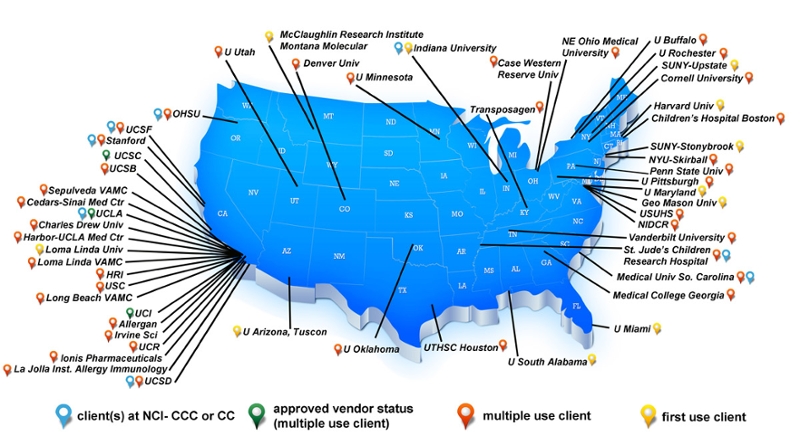Frequently Asked Questions
Since its inception in 1996, the UC Irvine Transgenic Mouse Facility (TMF) has provided services for design, making, breeding, genotyping, importing, and preserving a wide range of genetically modified mice. The TMF is a Shared Resource funded in part by the Chao Family NCI-Designated Comprehensive Cancer Center Support Grant (P30CA062203) from the National Cancer Institute.
The TMF provides standard services such as production of transgenic animals via pronuclear microinjection, development of ES cell derived gene-targeted modifications, embryo and sperm cryopreservation and reanimation, and genotyping. We also offer services in targeted transgenesis (at ROSA26 and H11), BAC transgenesis, development of new lines of ES cells, chromosome counting services, single blastomere injection, Southern analysis, and molecular cloning services to develop targeting constructs and BAC transgenes. The TMF also has significant experience using CRISPR/Cas9 based methodology for genome engineering, having completed over 100 projects involving use of CRISPR. A strength of the TMF is its ability to partner with PI's to develop new methodology for modification and analysis of the mouse. Since its inception in 1996, the TMF has generated hundreds of lines of genetically modified mice.
Yes ! There are lots of creative ways to use this technology both in mouse embryos and in ES cells. The TMF has made mice with a variety of genome editing tools. Even if you don't know where to begin, contact the TMF to ask for advice on how this technology can be applied to your project.
Success in production of random integration mice via microinjection of DNA constructs (ranging from small transgenes to BACs) is extremely high (>97% of projects successfully completed). Production of germline transmitting chimeric mice using ES cell clones targeted within the TMF is also very high (>95% of projects successfully completed). Efficiency of sperm cryopreservation, based on ability to reanimate strains using frozen sperm, is extremely high (>98% of projects successfully completed). Efficiency of producing genome engineered mice via CRISPR / Cas9 targeting is also highly successful. To date we have found the efficiency of CRISPR / Cas9-mediated engineering is dependant on the locus being targeted and the crRNA being used. In general, generation of null alleles via cleavage followed by non-homologous end joining (NHEJ) is extremely efficient, as is introduction of small sequence modifications (e.g. loxP sites, missense mutations) via ssODN or ssDNA. Introduction of longer DNA sequences, particularly those with homology to the target sequence, can also be accomplished with efficiency. Introduction of significantly larger DNA sequences (e.g. a 60kb swap to humanize a mouse locus) can also be acomplished in ES cells using CRISPR. We encourage you to contact the TMF to discuss how to optimize success of your specific project.
In addition to UCI Investigators, the TMF supports Investigators at other UC campuses, other Universities and commercial entities. Approximately one third of the services are provided to off campus investigators at academic and commercial institutions throughout the USA (see below for map of previous and current TMF clients). Approved vendor status (green map markers) denotes campuses whose veterinarians have reviewed practices and animal health history within the UCI TMF and who permit importation of genetically modified mice generated in the TMF directly into an Investigator's animal facility without quarantine.
No. Once a signed Service Request Form (SRF) is received from a client (on or off campus), a project number is immediately assigned - e.g. 15047 would correspond to the 47th project in 2015. Once assigned, projects are processed as efficiently as possible, in order of receipt.
You are requried to have approval to use mice from your institution's Animal Care and Use Committee (IACUC). Once you have this approval, please submit the following to the TMF
- A signed Service Request Form (please request the latest form from the TMF and return the completed, signed form to the TMF by e-mail).
- Any client specific materials required to perform your project - e.g. targeting constructs, BAC DNA, plasmid DNA, ES cell lines. Please contact the TMF and review the relevant service to identify specific requirements for such materials.
- Documentation showing institutional approval for use of the transgenic animals and for making the recombinant DNA.
- For non-UC clients, a standard MTA is also required – contact the TMF.
This can vary and depends on several factors. The minimum turnaround time to transfer or ship G0 (founder) mice is about 7-8 weeks. However, it can take longer, depending on necessary design and planning for your project and how many orders are scheduled ahead of yours. Due to genetic mosaicism in G0 founders plus potential issues with their breeding, the TMF strongly advocates to ship N1 heterozygous mice to clients in which the desired genetic modification has been verified. Please note, injections or electroporation of zygotes or ES cells cannot be scheduled until a completed Service Request Form, the necessary documentation, and plans and any necessary materials have been received by the TMF.
Building Targeting Constructs
We provide advice on the strategy to generate targeting constructs. These can include long single stranded DNA for use as HDR templates in CRISPR-based targeting, or recombinant BAC clones for much larger targeting projects in ES cells. We can suggest vendors who will generate the construct on a fee for service basis. Ask the TMF for more details.
ES cell mediated targeting, including CRISPR-based BAC clone targeting
We offer all services necessary to introduce a targeting construct into ES cells, select clones, characterize them by Southern blot, expand selected clones for long-term storage, prepare clones for microinjection, and inject ES cells into blastocysts to make chimeric mice. We strongly urge clients to consult with us prior to making targeting constructs and to do a thorough search for mutant mice, ES cells, or targeting vectors that may already be available for their gene of interest. ES cell clones for microinjection should be sent on dry ice to the TMF (they will be stored in liquid nitrogen on arrival). Plan to send at least 2 vials per clone if pathogen testing is necessary.
CRISPR/Cas9-mediated targeting in zygotes
We offer advice on design of gRNA sequences as well as design of any DNA construct required to introduce defined sequence changes into the mouse genome. We continue to evaluate novel ways to do this via microinjection or electroporation of fertilized mouse oocytes. For information on how to apply CRISPR/Cas9-mediated targeting to your project, please contact the TMF.
Yes! We can generate genetically modified mice for outside institutions, non-profit or otherwise. Please contact the TMF to discuss your specific needs.
Contact the TMF for all questions regarding the progress of individual projects. Email is the preferred method of communication. The TMF reviews progress of projects at weekly meetings. A summary progress report is provided to clients after each review.
The answer depends on what we are going to do with the construct. In all cases, you should first determine that the construct was correctly engineered, e.g., by sequencing, restriction mapping, and/or functional testing.
For transgenes that will be injected into pronuclei of fertilized mouse eggs to produce random integrants, you should do a plasmid prep using the Qiagen Endo-Free Plasmid Maxi Kit to obtain at least 50 micrograms of clean DNA. Digest 50 micrograms with suitable restriction enzyme(s) to release the transgene from the plasmid backbone. Run a small amount of this digest on an agarose gel to check for completion of digestion and presence of the expected bands. If the digest looks good (no extra bands, no degraded DNA), send the remaining reaction mix and the gel picture to us. We will perform the final purification of the transgene DNA fragment. If your construct is a BAC, we will perform DNA purification. We will inject either linearized or circular BAC constructs.
For targeting constructs that will be electroporated into ES cells (other than those targeting the ROSA26 or H11 loci), you should purify ~200 micrograms of plasmid DNA using the Qiagen Endo-Free Plasmid Maxi Kit. An aliquot of the prep should be tested to make sure it can be linearized as planned, by restriction digest. We will linearize the remaining DNA and perform the final purification.
For constructs targeting the ROSA26 or H11 loci to insert a single-copy transgene, you should purify ~50 micrograms of plasmid DNA using the Qiagen Endo-Free Plasmid Maxi Kit. An aliquot of the prep should be tested by restriction digest and targeted sequencing to verify the expected structure.
Commonly used methods for testing constructs include: sequencing the DNA, doing in vitro expression (i.e. in cell culture), injecting it into frog oocytes. None of these methods will guarantee that you will get expression of your transgene in the founder mice. However, they can reveal mistakes in design or engineering that prevent expression. One method for testing new promoters is to join them with a reporter gene (e.g., lacZ or GFP) and make "transient" transgenics, i.e., look for expression during gestation. This can cut 4-5 weeks from the normal turnaround time.
Usually, extremely good. Although we cannot guarantee expression of the transgene, the standard service does guarantee to produce at least 3 transgenic founders, or a total of 50 pups, whichever comes first. Out of 137 different transgenes injected by us from 2006-2011, only 3 constructs failed to produce at least one founder after we had produced at least 50 pups. Out of 71 constructs injected under the One-Day service during the same time period, 4 failed to produce any founders.
If the male carries the mutation of interest, we can harvest sperm from him and attempt to sustain the strain through in vitro fertilization, but it is unlikely that the females would yield viable germplasm, although this can be attempted. Cloning via somatic cell nuclear transfer and production of induced pluripotent stem cells are two methods that could theroretically be used to revive the strain using tissues from the females, but these methods are not currently offered by the TMF.
Rederivation involves harvesting embryos from one set of mice, washing extensively, and transferring the embryos to pseudopregnant foster mothers, followed by testing of the foster mothers' serum. If done correctly, this method is guaranteed to eliminate all mouse pathogens currently excluded from UCI vivaria. Please note that different mouse holding rooms have different criteria for pathogen exclusion. The so-called "barrier" holding rooms exclude Helicobacter and mouse norovirus, but these are not currently excluded from other holding rooms. Mice produced by our rederivation service can be housed in any UCI holding room. Also, please note that mice can be imported in several ways:
- As live mice.
- As frozen embryos.
- As frozen sperm.
The process by which mice are revived from frozen germplasm involves the same procedures as our rederivation service. In the case of frozen sperm, we would first perform IVF to generate fertilized embryos, then follow the usual rederivation process.


